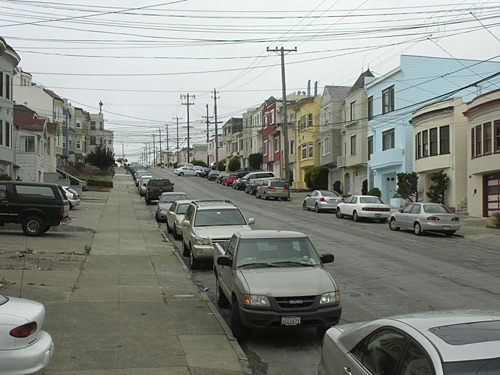 Calendar of events. There are no events scheduled at this time - stay tuned. Calendar of events. There are no events scheduled at this time - stay tuned.

 View the View the
Final Better Streets Plan
Now available!
|
Photosimulations are for visualization purposes only, and are not intended to show specific details and dimensions
|
The Better Streets Plan will improve the streetscape and pedestrian environment for all users. Roll mouse over the images below to see how Better Streets Plan improvements can transform a typical commerical and residential street. Photosimulations by Urban Advantage.

Photosimulation of a typical commercial street

Photosimulation of a typical residential street

The Better
Streets Plan creates a unified set
of standards, guidelines, and implementation strategies
to govern how the City designs, builds, and maintains its pedestrian
environment.
The
Better Streets Plan process brings together staff of multiple
City agencies to comprehensively plan for streets. The Plan
seeks to balance the needs of all street users, with a
particular focus on the pedestrian environment and how streets
can be used as public space. The Plan reflects the understanding
that the pedestrian environment is about much more than just
transportation – that streets serve a multitude of social,
recreational and ecological needs that must be considered when
deciding on the most appropriate design.
The Better Streets Plan carries out the intent of San Francisco's Better Streets Policy, adopted by the Board of Supervisors on February 6, 2006.
Guide to the Better Streets Plan  2.0 MB 2.0 MB
Better Streets Plan Fact Sheet  0.6 MB 0.6 MB

The
Better Streets Plan promotes a balance between all the functions
of a street, and puts people and quality of place first. The
City’s DRAFT Vision for the Better Streets Plan is as
follows:
The
Better Streets Plan will result in a street system designed
to promote human needs for the use and enjoyment of public
streets. It will prioritize the needs of walking, bicycling,
transit use, and the use of streets as public spaces for
social interaction and community life, following San Francisco’s
General Plan, Transit-First Policy, and Better Streets
Policy.
The
Better Streets Plan will result in streets where people
walk and spend time out of choice—not just necessity—because
streets are memorable, engaging, safe, accessible, healthy,
attractive, fun, and convenient.
The
Better Streets Plan will result in a green network that
enhances the City’s long-term ecological functioning
and people’s connection to the natural environment.
Finally,
the Better Streets Plan will result in improved street-based
social opportunities, community life, access, and mobility
for all San Franciscans, regardless of cultural identity,
income group, neighborhood identity, or mobility level.
Click
here to read the full set of DRAFT
Better Streets Plan Goals and Objectives  3.4
MB 3.4
MB

The
Better Streets Plan, if fully implemented, will result in an
enhanced pedestrian realm, which will help to realize a number
of essential benefits for San Francisco and its residents.
It will:
- Help
retain families in San Francisco: Streets that
are safe from fast-moving traffic, are clean and well-maintained,
and have spaces for neighbors to gather or children to
play will help to retain families in San Francisco, much
as affordable housing or good public schools will do the
same.
- Support
Muni and a transit-first city: Every transit trip
begins and ends with a walking trip. Well-designed streets
that are safe for pedestrians, have amenities that people
need, and connect to important transit lines will encourage
greater use of the Muni system.
- Help
promote public safety: Streets that are active
and have ‘eyes on the street’ will enhance
residents sense of safety and security from crime and violence.
- Help
to minimize impact on global climate change and local air
pollution: Streets that are designed to promote
walking, cycling, and transit use over private automobile
use will help to minimize San Francisco’s contribution
to global climate change, and reduce local air pollution.
- Help
to minimize sewer/stormwater overflows into the Bay: Streets
can be designed such that they detain a certain percentage
of water during big storms. This helps reduce overflows
of the City’s combined stormwater and sewer infrastructure
into the bay, and also reduces local flooding problems.
- Decrease
the likelihood of pedestrian injuries and fatalities: Streets
that are designed with the safety of pedestrians in mind
will decrease the likelihood of pedestrian/auto collisions,
and the number of pedestrian injuries and fatalities that
occur each year.
- Increase
accessibility for all street users: Streets
that have a clear, accessible path of travel and are free
from barriers and obstructions will result in increased
usability for all users, including people with disabilities,
seniors, children, parents with strollers, and everyone
in between.
- Support
the City’s local shopping districts and small businesses: A
street system that encourages people to walk to neighborhood
commercial districts rather than drive to regional shopping
centers for their daily needs helps to support the small
commercial areas and small businesses that make up an important
part of San Francisco’s character.
- Provide
open space in areas that are lacking: As San Francisco
grows and new neighborhoods emerge, there is increasing
pressure on the City’s existing open spaces, and
a need for open space in new neighborhoods. The city’s
street system can complement and link to the larger open
space network, bringing more open space to underserved
neighborhoods.
- Support
neighborliness, civic interaction, and identity: Cities
depend on peaceful interactions of colleagues, neighbors,
and strangers who share a collective identity and pride
as the residents of a place. Well-designed streets that
include places to sit, stop, gather, and play create the
spaces for this interaction to take place.
- Enhance
the everyday quality of life for San Francisco’s
residents: Above all, a well-designed street system
will enhance the livability—pleasant places to stroll
or sit, opportunities for neighborly interaction, freedom
from excessive noise and pollution, and a green, attractive
cityscape—for San Francisco’s residents.
  
|










